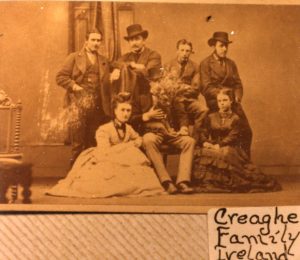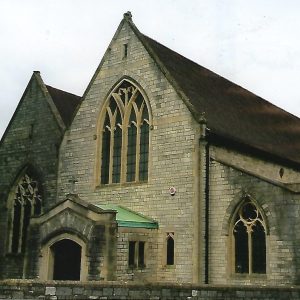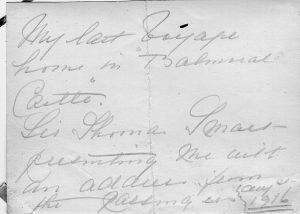27 Feb John W.W. Creaghe and Julia Rae Creaghe
John William Wentworth Creaghe (1853-1931)
Julia Rae Creaghe (1861-1955)
We know relatively little from direct sources about John W. W. Creaghe and even less about Julia Rae, his wife of forty-two years. However, the data we do have, plus interferences and extrapolations from indirect sources, can lead to a reasonable representation of their lives.
John was born the sixth of nine children to Richard F. H. Creaghe and Anna Maria Archer-Butler at either Clonmel or Waterford, Ireland on September the 13th, 1853. The family referred to him as “Jack.” There is no direct information about his childhood, but it must have been very active with so many siblings so close in age. His level of formal education is not known, but it probably ended in his late teens.
The family appears to have been reasonably well to do as can be inferred from family photos. However, the source of Richard’s income was not the kind of thing that could be passed on to his sons. Of the six boys who reached adulthood, only one remained in Ireland; four chose the new world, and Jack chose the sea.
It has not been determined just when he first became a sailor, but he was certified as a Second Mate on June the 22nd, 1875 at age 21. He was undoubtedly serving as an ordinary seaman for at least several years before that. A high level of competence and ambition can be assumed in that he was certified a First Mate one year later and made Master at age twenty-five in 1878. This was an accomplishment. For instance, the most famous and highly accomplished ocean liner captain of all time, Edward J. Smith, earned his Master’s certificate at the same age and only three years prior to John in 1875. Were they acquainted? Quite possible. More about him later.
We have little hard data regarding John’s career, but good extrapolations can be made. More facts are available at the National Maritime Museum, Greenwich, but these have not yet been explored.

This photo was probably taken soon before his marriage to Julia Rae, an English girl, in 1889. At the time, John was about 36 and she was ten years younger. There is no information about where and how they met, but the marriage was in the Strand neighborhood of London. London, of course, was a port city, but it is not known if John was based there at that time.
This photo of John was taken in 1894. We don’t know where they lived for the first five years of their lives together , perhaps London.
Based on the next photo, it can be assumed that the Creaghes had been living in Southampton sometime before 1905, because the city was home port for the bulk of the Union-Castle company’s South Africa shipping routes.
We know they lived at 19 Highfield Road for some time before 1920. The house was nicely located just across the road from Southampton Common providing a delightful view and access to the park. The house was raised, perhaps as early as 1926, to make way for what eventually became the Avenue Campus of Southampton University. There are still some homes standing in the area, which are probably representative of the Creaghes’ home, but number 19 did not survive (see Google Maps).
They probably started attending Highfield Church (see “Sites”) at the junction of Highfield Lane and Church Lane on their arrival of the city. The church was about a ten-minute walk from their home. They were members of the parish until their deaths, and it was an integral part of their lives as we will see.
Fellow parishioner and contemporary of the family were the aforementioned Captain Edward J. Smith, his wife, Sarah, and daughter, Helen, who lived about a twelve- minute walk away at 34 Winn Road. This house was imposing enough to have a name: “Woodhead.” The red brick, twin gabled home is also no more – replaced by an apartment house, Chatham Court (Reader, p. 14).
Three years older and moving up the ranks three years before John, Smith started working for the White Star Line in 1880 and continued there for the rest of his career. Over the years, he became one of the most experienced and respected ocean liner captains in the world. He was designated Commodore of the White Star Fleet. All this in the golden age of transatlantic ocean liners. His reputation was such that travelers saw him out and sailed only in ships he commanded. He was actually known as the “Millionaire’s Captain (Wiki).” Clearly, he had risen to a level few achieved. So, they had much in common. Were they friends? Not possible to know with the current information. Did they know each other? Almost certainly.
The next piece of hard data from the photo is that it is attributed to a “supplement of South Africa” – a magazine or some other publication. As usual, we have some facts and can make suppositions.
At the time the 1905 picture was taken, John was a fifty-two -year-old man and certainly looks like a sea captain at the peak of his powers; erect, flinty gaze, ready for anything. The designation “Capt.” Indicates that he was a ship’s commanding office for the Union-Castle Steamship Company. The two thick and one thin stripes on his sleeve indicate a British Merchant Navy rank of Lieutenant Commander. A mariner of that rank was qualified command a ship of up to 10,000 tons displacement – not that large, but not small either.
His role was part of the backbone of the Union-Castle Line’s business: carrying mail and passengers between Southampton and Cape Town, South Africa and back (around 14,000 miles round trip). It worked like clockwork. Every Thursday at 4 p.m., a Union-Castle ship would depart Southampton, and another would leave Cape Town. The trip could have taken around twenty days one way. Captain Creaghe must have been doing this for some time by 1905 and was well respected, or he would not have been the subject of an article in “South Africa”.
Obviously, John was away at sea a great deal. Julia knew that she was marrying a sailor and adapted. There must have been a substantial peer group of wives in similar circumstances in Southampton that could offer each other support. From time to time, they would need it.
In 1912, Edward Smith was given, as was the company custom, command of the White Star Line’s newest, largest, most prestigious ship for her maiden voyage. Not long after dawn on Wednesday, April 10th, he left his Winn Road home “wearing a bowler hat and long overcoat, took a taxi from his home to the Southampton docks.” After a ten or fifteen-minute drive, he arrived dock side and boarded RMS Titanic at 7:00 a.m. At noon, the ship sailed. Did he say goodbye to his wife and family before he left or let them sleep? Did they go to the dock to see the departure or was it routine by then? Just before midnight four days later, the ship struck an iceberg and sank in less than two hours with the loss of about 1,500 souls, including Captain Smith.
Five-hundred and fifty members of Titanic’s crew who were lost, lived in Southampton. Five of that number, including the Captain, attended Highfield Church. What a blow that must have been to the city and church. How were John and Julia affected? Was he at sea? Was Julia one of those who comforted Sarah and Helen? Was there a memorial service at the church? Probably. What was it like? Who was in attendance? Some of these answers may well lie in the newspapers of the day.
No other information about the Creaghes’ lives at this time is available until this photo. It comes from an album – Percy Creaghe’s most likely- and actually tells us quite a bit. In the album, the photo is labeled “Balmoral Castle” above and “Sir Thomas Smartt” and “Uncle Jack” below the picture. On the back, the photo is annotated by John himself:
“My last voyage
home in Balmoral
Castle.
Sir Thomas Smartt
presenting me with
an address from
the …… Aug 1916
Several things can be learned from this image. Most likely, this is John’s last voyage before retirement, and it is in Balmoral Castle. It is apparent that the sixty–three-year-old Captain was quite respected by both his company and South Africa itself. From the Union-Castle Company’s perspective, he was given command of the Balmoral Castle, a significant passenger liner. She displaced 13,361 tons and was 513 feet long, and could carry 513 passengers (307 first class, 216 tourist class) at up to 16.5 knots. She was quite new in 1916, having been built only six years earlier. At over 13,000 tons, Balmoral was one of the four largest ships in the Union-Castle Fleet at that time. Companies did not give commands of vessels like this to just anyone – only their most experienced and respected captains. This link shows that Balmoral Castle was certainly a first-rate ship.
Interestingly, since the ship was larger than the 10,000 tons that a Lieutenant Commander was rated to command, perhaps John had been promoted to Commander sometime after 1906 and before assuming command of Balmoral Castle. There is not a clear view of his uniform sleeve in the photo.
John’s retirement was significant enough to be noted in the “South Africa” publication and to warrant the attention of Sir Thomas Smartt. The writing on the reverse of the photo is not legible, but presumably, the award presented by Smartt is the plaque John is holding.
Sir Thomas, in the white trousers, was a South African politician of some national stature. He held multiple positions in government, including acting prime minister of Cape Colony (now Cape of Good Hope Province) in 1905 and later as a member of parliament and minister of agriculture in the Union of South Africa Government. (Wiki)
There is very little hard data available at this time about John and Julia’s lives after retirement. We do have a photo of the two of them in a garden setting. They both look contented.
Highfield Church seems to have been a significant part of their lives. In 1925, they presented the church with a brass offertory plate, approximately 12 to 18 inches in diameter. In use to this day, it is kept on view near the altar. Following John’s death in 1931 at age seventy-eight, a ship model and plaque were dedicated in his name (see Artifacts). In the summer of 2017, the model was due to be moved as part of a renovation, and the new location is not known at this writing.
Julia lived on until June 30th, 1955, dying at age ninety-four. At the time of her death, she was living at 116 Highfield Lane, a few houses down from the church. Her remains were scattered in the South Stoneham Cemetery Garden of Rest, Section 3, in Southampton. Definite records of John’s burial have not been found, but there is evidence his remains may well lie in the same place. The couple had no children. She left her estate of £16,156 7s to Kenneth Edward Rae in 1955. That would be worth $400,000 today.
John and Julia led the lives of an Irish sea captain and his wife. They made their home in a port city where their church was a significant part of their lives. John rose to a high level in his profession and was given great responsibilities by his company. He was the real thing.
Stephen B. Creaghe, March 1, 2018
References:
Ancestry, varius.
Moore, Helen Gordon, Genealogy Book, ca. 1997. CFHS Library.
Reader, Elizabeth, Highfield Church Southampton, self published,1998. CFHS Library.













No Comments